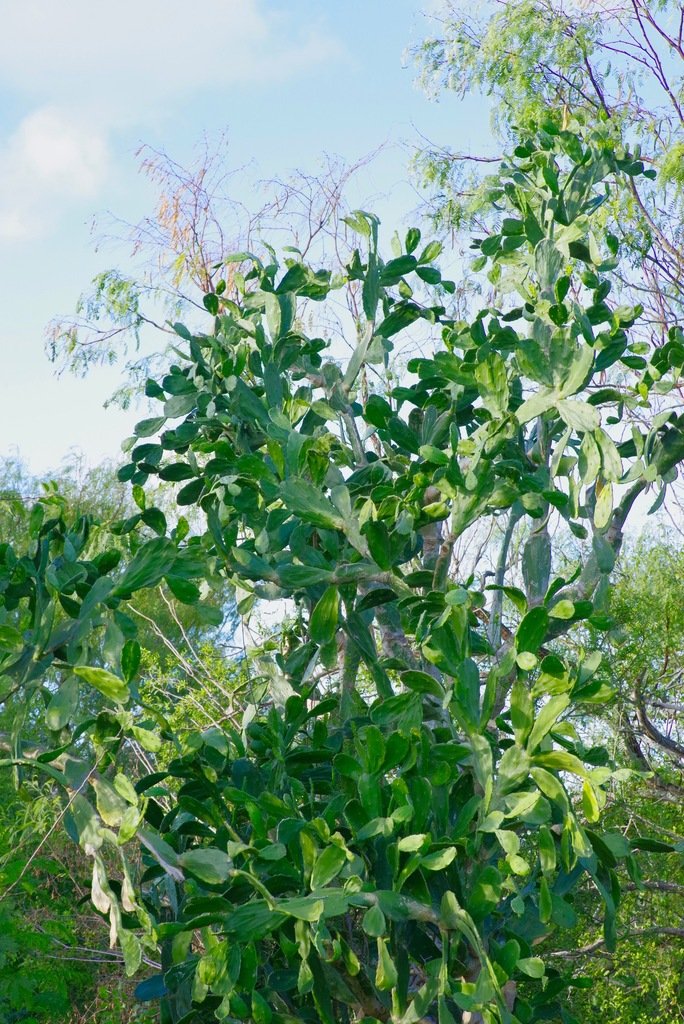Cochineal Nopal Cactus
Opuntia cochenillifera
Family: Cactaceae
This is typically an arborescent (treelike) plant that can reach 10-12’ tall in protected spots. The pads are nearly spineless and longer than wide, and bright green. This species has unusual flowers (for a pricklypear), they are reddish pink and more tubular, or at least the petals point forward to form a tube to accommodate their preferred pollinator, hummingbirds. They usually occur in the cool season, and form on the top of the pads of the uppermost joints. The fruits that follow start off as green but turn red.
Plant in full to part sun. Plants require low water, but watering a few times a month in summer will encourage healthy growth. Water seldom if at all in winter, maybe only if there is absolutely no rain. This species is hardy to about 20°F.
Plant in full sun. Plants require low water when established, but watering once or twice a month in summer is a good idea to keep plants healthy. Container plants need water 1-2 times a week in summer, and maybe monthly in winter. This is a very cold hardy prickly pear that can tolerate temperatures down to 0°F.
We recommend watering plants in the summer when there is drought to prevent rots. During droughts plants will have natural root dye-back, and this is normal. But during extended droughts like the two year drought of 2019-2020, plants had excessive root dye-back and when the rains finally came, many plants just rotted. Many people thought that the really wet summer is what rotted the cacti, but it was the response to copious moisture coming into contact with lots of dead roots, and those rots chased up into the plants.
Flowers are very important for native bee species, though numerous other pollinators use the flowers. The seeds of the dried fruits are eaten by birds and many other animals. Prickly pear plants provide important habitat for birds, native rodents like packrats, and numerous other animals. Larval host for the tineid moth Dyotopasta yumaella, the grass moth Dicymolomia opuntialis, the snout moth Laetilia dilatifasciella, and the grass moth Pseudoschinia elautalis.
The fruits of this species are edible and the pads can be made into nopalitos. This species is used to create carmine red dye from cochineal insects—the insects feed on the plant and the female insects produce the red dye.
Opuntia is from Latin root puncti for prickled. The specific name of this plant was given because it is one of the species of cactus from which cochineal was obtained. Cochineal was long supposed to be a vegetable product; it was not until 1703 that, by the aid of the microscope, it was definitely determined to be of insect origin. There are approximately 176 species currently accepted for the genus. Like most true cactus species, prickly pears are native only to the Americas. Through human action, they have since been introduced to many other areas of the world. Sometimes known as Nopalea cochenillifera.
The species occurs in tropical dry forest. It is believed that it is originally native to a small area somewhere in Mexico but now is widely distributed in the west Indies and tropical America. The precise native range is not known. It is now cultivated and often naturalized throughout warmer regions of the world.
Sometimes plants will be bushier and not as arborescent. Photo by Vitor Abdala, iNaturalist
Unusual for pricklypear cactus, this species specifically depends on hummingbirds for pollination which has influenced the morphology of the flower. Photo by Nelson Wisnik, iNaturalist
The fruits turn red when ripe. Photo by "M" on iNaturalist




